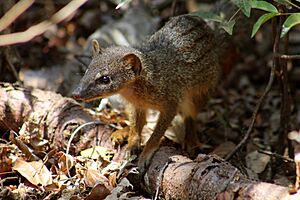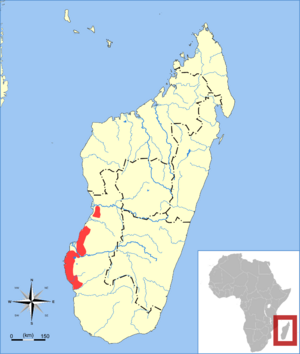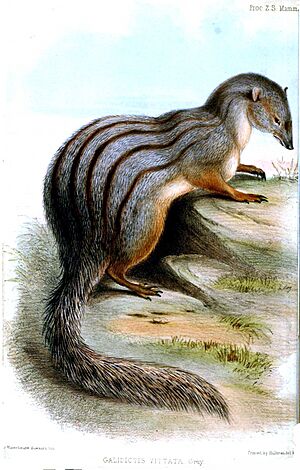Narrow-striped mongoose facts for kids
Quick facts for kids Narrow-striped mongoose |
|
|---|---|
 |
|
| Conservation status | |
| Scientific classification | |
| Genus: |
Mungotictis
|
| Species: |
decemlineata
|
 |
|
| Narrow-striped mongoose range | |
The narrow-striped mongoose (Mungotictis decemlineata) is a special animal found only on the island of Madagascar. It belongs to a family of animals called Eupleridae. You can find it in the western and southwestern parts of Madagascar, living in woodlands and spiny thickets. It lives from sea level up to about 125 meters (about 410 feet) high, between the Tsiribihina and Mangoky rivers. In the Malagasy language, people call it bokiboky (pronounced "Boo-ky Boo-ky"). It is the only species in its group, called Mungotictis.
Contents
About the Narrow-Striped Mongoose
The narrow-striped mongoose was first described by a scientist named Alfred Grandidier in 1867. He called it Galidia decemlineata. Later, in 1915, another scientist named Reginald Innes Pocock placed it in its own special group, the genus Mungotictis.
The Mongoose Family Tree
The narrow-striped mongoose is part of a unique group of meat-eating animals from Madagascar, all belonging to the Eupleridae family. These animals are all related and share a common ancestor. They are part of a larger group of animals called Feliformia, which includes cats and other cat-like creatures.
Daily Life and Habits
The narrow-striped mongoose is active during the day. This means it is a diurnal animal. They live in family groups led by females, which is called a matriarchy. These groups work together to raise their young. Usually, the babies of the main female get the most care. Sometimes, the young of lower-ranking females might not get enough attention and are even left alone.
These mongooses have interesting social habits. Female groups, usually 1 to 3 females with their babies, have their own home areas. Males also form their own groups, with 2 to 4 adult males. The male groups have much larger home areas that often overlap with several female groups. This helps males and females find each other to mate.
Narrow-striped mongooses make small nests in trees and bushes. They have even been seen sharing trees with certain lemur species, like the Lepilemur, without bothering each other.
What Do They Eat?
Scientists have studied what the narrow-striped mongoose eats. It seems they mostly eat invertebrates, which are creatures without backbones, like insects. They also eat bird eggs and other small animals. This can include rodents, birds, snakes, and even tiny lemur species, such as the gray mouse lemur.
They look for food in the top layer of soil, in leaves and twigs on the ground, and in rotten wood from fallen trees. Their diet mainly includes arthropods (like insects and spiders), insect larvae (baby insects), and gastropods (like snails). Scientists have also found bits of reptile eggs, bones, and feathers in their droppings. This shows they eat a variety of foods.
During both the dry and wet seasons in the Kirindy Forest, invertebrates are their main food source. They seem to eat whatever food is available, rather than being picky about what they eat. Insect larvae are a very important part of their diet. Snails are also a main food source during the rainy seasons.
Reproduction and Life Cycle
Male narrow-striped mongooses often mate with more than one female. Females can also mate with more than one male. Mongooses from nearby groups are often related, especially the females. This is likely because females tend to stay closer to their birth area.
Females usually give birth to one baby per season. This often happens at the end of the dry season, between October and December. If a baby dies, the mother might have another one by February or March. However, many young mongooses do not survive. Only about 28% of the babies make it to adulthood. Often, it's the oldest baby of the most dominant female that survives. The mother carries her baby for about 74 to 106 days before it is born.
Protecting the Narrow-Striped Mongoose
The narrow-striped mongoose is currently listed as an endangered species on the IUCN Red List. This means it is at a high risk of disappearing forever. They live in areas that are very broken up, like islands of forest surrounded by other land uses. Their biggest threat is losing their habitat. This happens because of logging (cutting down trees) and turning forest land into farms.



